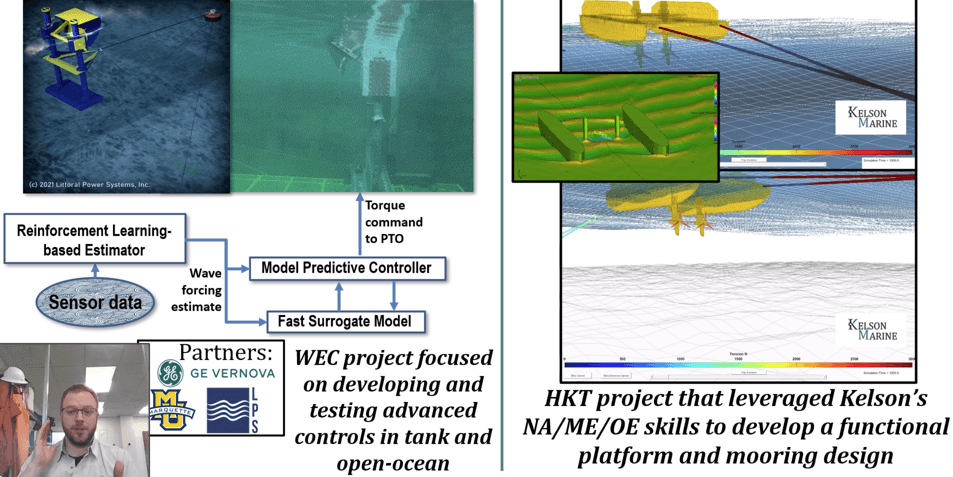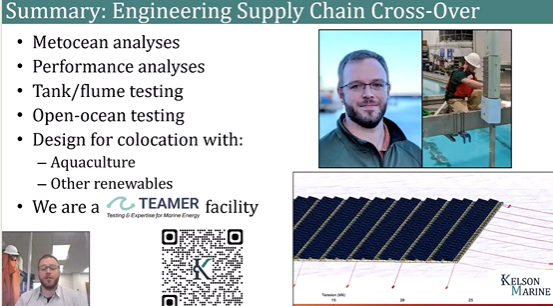
Kelson Marine IPF Ocean Renewables Summit: Crossover between Offshore Wind and Renewables
Kelson Marine IPF Ocean Renewables Summit
Watch Doug Slocum, PE, present on Supply Chain Crossovers Between Ocean Renewables and Offshore Wind
Glimpse what Kelson and collaborators have been working on in marine renewable energy and related industries. Douglas Slocum's contributions to the panel on Supply Chain Crossovers Between Ocean Renewables and Offshore Wind, at Oceantic Network's Ocean Renewables Summit.🌊 At Kelson Marine, we bring model-based design + technoeconomic analysis to ocean energy—helping projects optimize for both CAPEX and long-term operations.
🌀 Our recent work includes:
A multi-body wave energy converter (WEC) showing >10% energy gains using advanced control strategies.
Fast-tracked hydrokinetic turbine platform design—from sketch to prototype-ready in just 2 months.
Long-term metocean + extreme event analysis to push the envelope of industry design standards.
🔁 What transfers from offshore wind?
Moorings, anchors, substations = highly portable.
WEC-specific PTO + mooring needs = more bespoke, but design lessons from floating wind are highly relevant.
🚀 The wave energy space is still the "wild west"—but that's what makes it exciting. Lots of R&D, lots of promise.
👩🔧 Building the next-gen workforce? Support student competitions like MECC. They're inspiring the engineers who’ll shape the future of marine renewables.
Kelson's Naval Architect Present on Offshore Wind and Marine Renewables
Watch Here!
Kelson naval architect Doug Slocum spoke at the Ocean Renewable Energy Summit during IPF 2025, tackling a big question: How can offshore wind and ocean renewables share a supply chain?
A few key takeaways from the panel:
🌊 At Kelson Marine, we bring model-based design + technoeconomic analysis to ocean energy—helping projects optimize for both CAPEX and long-term operations.
🌀 Our recent work includes:
A multi-body wave energy converter (WEC) showing >10% energy gains using advanced control strategies.
Fast-tracked hydrokinetic turbine platform design—from sketch to prototype-ready in just 2 months.
Long-term metocean + extreme event analysis to push the envelope of industry design standards.
🔁 What transfers from offshore wind?
Moorings, anchors, substations = highly portable.
WEC-specific PTO + mooring needs = more bespoke, but design lessons from floating wind are highly relevant.
🚀 The wave energy space is still the "wild west"—but that's what makes it exciting. Lots of R&D, lots of promise.
👩🔧 Building the next-gen workforce? Support student competitions like MECC. They're inspiring the engineers who’ll shape the future of marine renewables.
Let’s keep pushing the blue economy forward. Reach out if you’re building in this space—we’d love to collaborate.

Full transcript
Hey, Doug Sloum, Naval Architect at Kelson Marine up in Portland, Maine.
Last week, I had the honor of attending the Ocean Renewable Summit, part of the programming at IPF, put on by Oceanic. I was also further honored to be on a panel discussing supply chain crossover between offshore wind and ocean renewable energy.
Jason Cotrell of Sperra was our moderator. I was joined on the panel by Robert Lensford of American Bureau of Shipping and Jen Matasen of Carbon Trust. We had a great conversation—I'll walk you through it real quick.
At Kelson Marine, we focus on bringing model-based engineering to the blue economy. We have years of experience analyzing ocean conditions and designing, modeling, and analyzing dynamic, flexible structures in the ocean—largely for aquaculture. I lead our renewable energy projects here, including wave energy, hydrokinetic energy (especially tidal), and floating solar and offshore wind.
As much as possible, we like to leverage hyperrealistic technoeconomic analyses. That means designing and optimizing systems—whether for aquaculture or renewable energy—not only for initial CAPEX and installation, but also for operations and maintenance over the system’s lifespan.
A good example: say you're weighing which gearboxes to use in your power take-off (PTO) system. With these TEAs, we can model your beta cycles and understand what that means for your operational costs down the road.
We also bring traditional naval architecture skills to the table—manned and unmanned vessel design, for example.
In all our projects, we develop a detailed understanding of the conditions at a given site—or series of sites. We use time-history data, whether from hindcast models, deployed sensors, or buoy data. For instance, we have about 22 years of wave and current data in the Gulf of Maine.
We don’t just look at normal operating conditions—we specialize in extreme event analysis. We model 25-, 50-, and 100-year storm conditions. One example: a 3D surface showing 50-year return conditions for waves and current. Industry standards might prescribe 50-year waves and 10-year currents separately, but when you combine them in a multivariate analysis, the real combined conditions can be far outside those assumed by conventional practice.
This kind of work helps us not only design to industry standards—but also, potentially, help influence them.
Recent Projects
One recent project has been a wave energy converter (WEC). Two things happening in parallel: one is a tank-testing effort where we’re proving out a novel control method for a multi-body WEC. I’m also leading the design of a larger WEC, which, if all goes well, will be deployed at PacWave, where we’ll test that control method in the open ocean.
It’s been a really cool project with partners at Marquette University, Power Systems, and GE Vernova. We’re hoping to get back into the tank soon for our final session. GE Vernova’s MPC controller—based on validated hydrodynamic models we’ve built at Kelson—has shown over 10% increase in energy production and a 20% reduction in peak PTO loads, just by changing the control methodology.
Another project: we worked on a hydrokinetic turbine platform. Kelson led system integration, platform design, and the mooring and anchoring design approach. We did a lot of dynamic modeling for those systems. We collaborated with subsystem experts and moved from napkin sketch to prototype-ready in about two months. A fast turnaround—and a very cool project.
In all of this, we emphasize system integration—ensuring functionality of mechanical engineering subsystems, their interconnections (whether plugs, piping, data flow, or power), and that the full system works when it all comes together.
We also do open-water deployments with instrumentation. We deploy sensors to capture environmental forces—waves, currents, wind—as well as structural data: load sensors on moorings, motion tracking, etc. We deploy these for as long as we can, then bring the data back to validate and refine our models.
Supply Chain Crossover
On the supply chain crossover between offshore wind and ocean renewables: from a design and engineering standpoint, there's a lot that can inform both. Metocean analyses, technology development, tank and flume testing, and open ocean testing all transfer well.
There are also opportunities for collocation—offshore wind combined with aquaculture or other renewables. That could mean co-locating in the same permit space, sharing moorings, or even integrating multiple technologies into a single floating platform.
We’re a TEAMER facility, so we can help early-stage technology developers get their systems designed and into the ocean.
Q&A Recap
One question I got was about hardware crossover between offshore wind and ocean renewables. I think of it by subsystem type.
-
Anchors? Definitely transferable.
-
Cables and substations? Absolutely.
-
Moorings? Often transferable—but mooring type (catenary, tension leg, etc.) matters. Especially for wave energy, moorings can significantly impact device performance, so they need to be considered early in design.
PTO systems are less easily transferable due to different kinematics—wind vs. wave/tidal mechanics—but some concepts could translate.
I also expect to see ocean renewables adopt more structural materials and construction techniques from floating wind—spiral-welded steel pipe, concrete, etc.
Another question: what's the state of wave energy?
I’d call it the "wild west." There’s no technical consensus yet on how a WEC should behave in a given wave environment. There are lots of device types, PTO configurations, and control strategies under development. Some are in or near pilot deployments, but there’s not yet commercial-scale adoption.
That makes it an exciting space with tons of research happening—especially around control systems and hydrodynamics.
Workforce & Training
We also discussed workforce development and training. Ports, vessels, and labor can transfer between offshore wind and ocean renewables. On the design side, I’ve seen collegiate STEM outreach make a difference. Programs like the Marine Energy Collegiate Competition (MECC) and similar ones for offshore wind get students excited about marine renewables.
One grad student I met said those kinds of programs were the reason they joined PNNL.
So just putting these opportunities on the radar for young engineers can help build the workforce we’ll need.
Thanks for your time. Feel free to reach out if you’d like to learn more or connect on any of this.